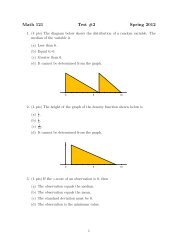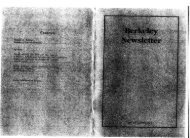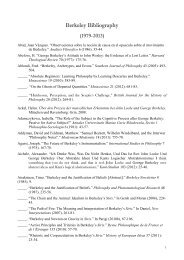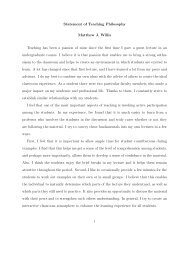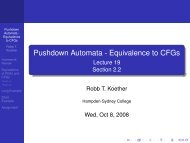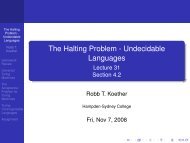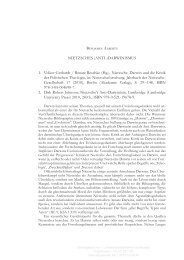Homework 4 Solutions: Thm. 2.20. There do not exists natural ...
Homework 4 Solutions: Thm. 2.20. There do not exists natural ...
Homework 4 Solutions: Thm. 2.20. There do not exists natural ...
You also want an ePaper? Increase the reach of your titles
YUMPU automatically turns print PDFs into web optimized ePapers that Google loves.
<strong>Homework</strong> 4 <strong>Solutions</strong>:<strong>Thm</strong>. <strong>2.20.</strong> <strong>There</strong> <strong>do</strong> <strong>not</strong> <strong>exists</strong> <strong>natural</strong> numbers m and n such that 24m 3 = n 3 .Proof: Let m, n ∈ N.Using the Fundamental Theorem of Arithmetic, express m = p r 11 · · · p rnn and n = q t 11 · · · q tm mwith p i , q j prime and r i , t j ∈ N for any i and j.Then m 3 = (p r 11 · · · p rnn ) 3 = p 3r 11 · · · p 3rnn and n 3 = (q t 11 · · · q tm m ) 3 = q 3t 11 · · · q 3tmm .Also, 24 = 2 3 ∗ 3.Case 1: p i ≠ 3 for any i.Then the prime factorization of 24m 3 contains 3 1 .Since every exponent in the prime factorization of n 3 is a multiple of 3, we see that 24m 3and n 3 have different prime factorizations.Case 2: p i = 3 for some i.Then the prime factorization of 24m 3 contains 3 3r i+1 , and 3r i + 1 is <strong>not</strong> a multiple of 3.Since every exponent in the prime factorization of n 3 is a multiple of 3, we see that 24m 3and n 3 have different prime factorizations.Thus in either case, 24m 3 and n 3 have different prime factorizations, so 24m 3 ≠ n 3 .Ex. 2.22. Show that √ 12 is irrational.Proof: For the sake of contradiction, assume that √ 12 is rational, i.e.a, b ∈ Z and b ≠ 0.Then √ 12b = a =⇒ 12b 2 = a 2 .√12 =abHowever, 12 = 2 2 ∗ 3, so following the logic of <strong>Thm</strong>. 2.20, the prime factorization of 12b 2has an odd number of 3’s, but the prime factorization of a 2 has an even number of (or zero)3’s.Thus 12b 2 ≠ a 2 , and we have our contradiction.∴ √ 12 is irrational.<strong>Thm</strong>. 2.26 Let p be a prime and let a be an integer. Then p <strong>do</strong>es <strong>not</strong> divide a if an<strong>do</strong>nly if gcd(a, p) = 1.Proof: By definition, gcd(a, p) divides both a and p.Since p is prime, only 1 and p divide p, so either gcd(a, p) = 1 or gcd(a, p) = p.(=⇒) Assume p ∤ a.If gcd(a, p) = p, then p | a, which is a contradiction.So gcd(a, p) = 1.with1
(⇐=) Assume gcd(a, p) = 1.If p | a, then p divides both p and a, which implies gcd(a, p) = p.Thus p ∤ a. .<strong>Thm</strong>. 2.32. For all <strong>natural</strong> numbers n, we have gcd(n, n + 1) = 1.Proof: For the sake of contradiction, assume gcd(n, n + 1) = d where d > 1.Then d divides n and n + 1, so n = d ∗ x and n + 1 = d ∗ y for some x, y ∈ Z.Then (n + 1) − n = 1 = dy − dx = d(y − x) =⇒ d | 1, which is a contradiction.∴ gcd(n, n + 1) = 1.<strong>Thm</strong>. A.19. For every <strong>natural</strong> number n,1 2 + 2 2 + · · · + n 2 =n(n + 1)(2n + 1).6Proof:Base case, n = 1: 1 2 = 1 = 1(2)(3)6= 1(1+1)(2∗1+1)6.Induction step, assume P k is true, i.e. 1 2 + 2 2 + · · · + k 2 = k(k+1)(2k+1)6.Then 1 2 + 2 2 + · · · + k 2 + (k + 1) 2= k(k+1)(2k+1) + (k + 1) 26= (k + 1)( k(2k+1) + 6(k+1) )6 6= (k + 1) 2k2 +k+6k+66= (k + 1) 2k2 +7k+66= (k + 1) (k+2)(2k+3)6= (k+1)((k+1)+1)(2(k+1)+1) , and so P6 k+1 is true.<strong>Thm</strong>. A.21. For every <strong>natural</strong> number n,Proof:Base case, n = 1: 1 3 = 1 = (1) 2 .Induction step: Assume P k is true, i.e.1 3 + 2 3 + · · · + n 3 = (1 + 2 + ... + n) 2 .1 3 + 2 3 + · · · + k 3 = (1 + 2 + ... + k) 2 .Then 1 3 + 2 3 + · · · + k 3 + (k + 1) 3 2
= (1 + 2 + ... + k) 2 + (k + 1) 3= ( k(k+1) ) 2 + (k + 1) 3 (by <strong>Thm</strong>. A.10.)2= (k + 1) 2 ( k2 + 4(k+1) )4 4= (k + 1) 2 ( k2 +4k+4)4= (k + 1) 2 ( (k+2)22 2 )= ( (k+1)(k+2)2) 2= (1 + 2 + · · · + (k + 1)) 2 , so P k+1 is true.Consider the following game involving two plyers, whom we will call player 1 and player2. Two piles each containing the same number of rocks sit between the players. At eachturn a player may remove any number of rocks (other than zero) from one of the piles. Theplayer to remove the last rock wins. Player 1 always goes first.<strong>Thm</strong>. A.29 For any <strong>natural</strong> number n of rocks in each pile to begin, player 2 has awinning strategy.Proof (by strong induction):Base case, n = 1: Here both piles have 1 rock. Player 1 must choose 1 rock whicheliminates 1 pile. Then player 2 chooses the other rock, which removes all rocks from thegame, so player 2 wins.Induction step: Assume that for any k ≤ n, P k is true, i.e. if each pile consists of k ≤ nrocks on player 1’s turn, then player 2 has a winning strategy.Now assume that the game starts with n + 1 rocks in each piles.Player 1 must choose some amount of rocks from one of the pile, say he chooses j rocksfrom pile x, where j ≥ 1 and x is either 1 or 2.Now pile x has n + 1 − j rocks and the other pile, call it pile y, still has n + 1 rocks.Let player 2’s strategy be taking j rocks from pile y.After player 2’s turn, it will be player 1’s turn and both piles will have n + 1 − j ≤ nrocks.Thus by the induction hypothesis, from this point on player 2 has a winning strategy.∴ P k+1 is true.<strong>Thm</strong>. A.31. Every <strong>natural</strong> number greater than 7 can be written as a sum of 3’s and5’s.Proof (by strong induction):Base cases (we will show this is true for n = 8, 9, and 10, the reason for this will becomeclear in the induction step).3
n = 8 : 8 = 3 + 5.n = 9 : 9 = 3 + 3 + 3.n = 10 : 10 = 5 + 5.Induction step: Now let n + 1 > 10 and assume P k is true for all 7 < k ≤ n, i.e. any<strong>natural</strong> number between 8 and n inclusive can be expressed as a sum of 3’s and 5’s.y.Then n + 1 = (n − 2) + 3, where 7 < n − 2 ≤ n.By the induction hypothesis, n − 2 can be expressed as a sum of 3’s and 5’s.Say there are x 3’s and y 5’s in the expression for n − 2 for some positive integers x andThen (n − 2) + 3 = n + 1 can be expressed as the sum of (x + 1) 3’s and y 5’s.∴ P k+1 is true.4






